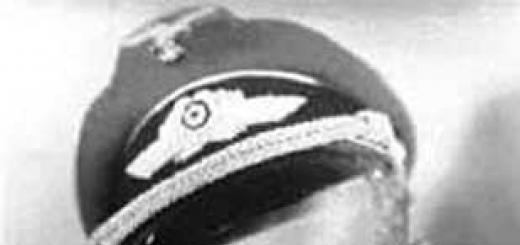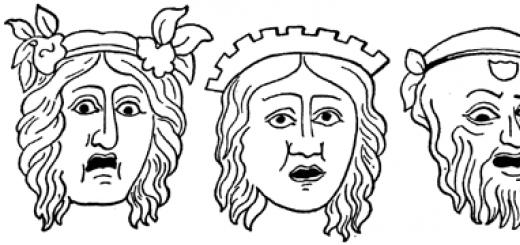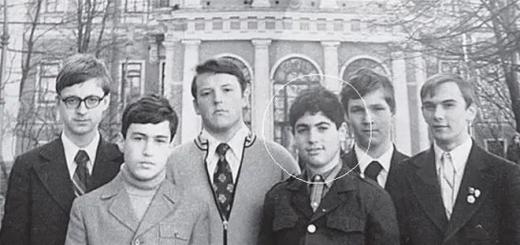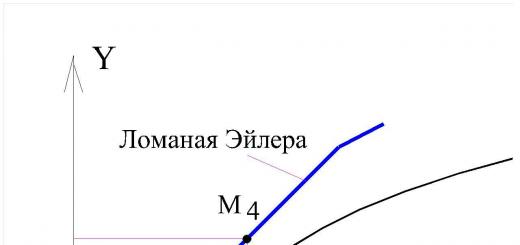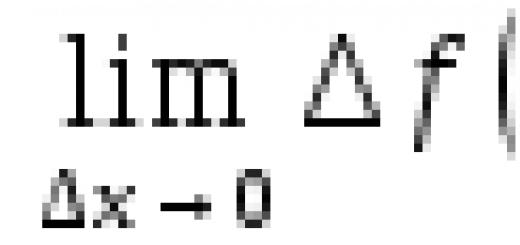Imagine a situation: a reporter from some local channel stops you on the street with an unobtrusive offer - to answer a series of simple questions about the country in which you live, study, work... If you doubt yourself, your knowledge, you will find thousands of reasons to avoid questions, you will want to move away, pass by, thereby avoiding a very delicate situation bordering on shame. It’s one thing to disgrace yourself in front of one person, and quite another to disgrace yourself in front of the whole country.
Recently, a video of just such a situation was shown on one of the state channels - in a crowded place, in the center of Moscow, a survey was conducted on the topic: “how do you know the geography of Russia.” The simplest questions were asked, and unfortunately most of the “test subjects” were embarrassed...
In this regard, we decided to introduce the “All about Russia” section, dividing articles into questions - answers on geography, history, and so on... Today we’ll start with geography. Test your knowledge here and now:
10 simple questions on Russian geography
1 Russia is the largest country in the world by area. Where is most of the territory of Russia located?
Answer: In eastern Europe and northern Asia
The European part of the country occupies about 23% of the area. Its border is the Ural Mountains, the border with Kazakhstan and the Kuma and Manych rivers.
The Asian part of Russia, occupying about 77% of the territory, lies east of the Urals and is also called Siberia (however, the exact definition of the boundaries of Siberia is a controversial issue) and the Far East.

2 How many subjects are there in the Russian Federation?
Answer: The Russian Federation consists of 85 constituent entities
Subject of the Russian Federation or abbreviated subject of the federation is the name of a territorial unit in the Russian Federation. According to the Russian Constitution of 1993, Russia is a federal state and consists of equal subjects of the Russian Federation. In total - 85 subjects. Of these, 22 are republics, 9 territories, 46 regions, 3 federal cities, 1 autonomous region, 4 autonomous districts.

3 How many time zones are there in Russia?
Answer: 11 time zones
Time in Russia is regulated by the Federal Law “On the Calculation of Time,” according to which, since October 26, 2014, 11 time zones have been established. It is curious that the Republic of Yakutia occupies as many as three time zones, the Sakhalin region two, while the rest of Russia lies within a single time zone.
4 How many countries border Russia?
Answer: 18 states
Russia recognizes the existence of borders with 18 states: Norway, Finland, Estonia, Latvia, Lithuania, Poland, Belarus, Ukraine, Georgia, Azerbaijan, Kazakhstan, China, Mongolia, North Korea, Japan and the United States, as well as the partially recognized Republic of Abkhazia and South Ossetia.
5 How many rivers and lakes are there in Russia?
Answer: More than 2.8 million rivers and ∼ 2,747,997 million lakes
There are more than 2.8 million rivers in Russia with a total length of 12.4 million km. Most of these rivers are relatively small and their length is usually no more than 100 kilometers. But as for large rivers, they are truly huge and reach shocking sizes. Read more about the largest rivers in Russia -
There are 2,747,997 lakes in Russia with a total area of 408,856 km (excluding the Caspian Sea). The largest lake is the Caspian Sea. From lakes in the traditional sense largest in area are Baikal (31,722 km²), Ladoga (17,872 km²), Onega (9693 km²) and Taimyr (4560 km²), and by volume Baikal (23,516 km³), Ladoga (838 km³), Onega (292 km³) and Khantay (82 km³), while about 96% of all lake water reserves are concentrated only in the eight largest lakes, of which 95.2% falls on Baikal alone. About the most beautiful lakes in Russia according to our magazine -
6 How many seas washes Russia?
Answer: Russia is washed by 1 closed sea and 13 seas belonging to three oceans
The seas of the Atlantic Ocean washing Russia:
- Baltic Sea
- Black Sea
- Sea of Azov
Seas of the Arctic Ocean washing Russia:
- Barencevo sea
- Pechora Sea
- White Sea
- Kara Sea
- Laptev sea
- East-Siberian Sea
- Chukchi Sea
- Bering Sea
- Sea of Okhotsk
- Japanese Sea
 Sunset over the Caspian Sea, filmed from space
Sunset over the Caspian Sea, filmed from space 7 How many people live in Russia?
Answer: More than 146 million people
Russia is considered the largest country in the world in terms of the size of its own territory, but as for the population, here our country is located only on the 9th place on the planet.
- China 1,339,450,000
- India 1,187,550,000
- USA 310,241,000
- Indonesia 237,556,000
- Brazil 193,467,000
- Pakistan 170,532,000
- Bangladesh 164,425,000
- Nigeria 158,259,000
- Russia 143,300,000
According to Rosstat, as of January 1, 2017, the total population of Russia is 146,804,372 people.
And yet, the Russian Federation is the most populated state in Europe. The average density is 8.36 people per square kilometer, but the fact is that population density is extremely unevenly distributed. So, about 80 percent of our compatriots are in the European part of the country, which makes up only 23% of the entire territory of the Russian Federation. If the population density, say, in Chukotka is 0.07 inhabitants per square km, then in Moscow, the capital of our homeland, the numbers are completely different - about 4,700 people per square km!
8 How many federal districts are there in Russia?
Answer: 8 districts
All subjects of the Russian Federation are united into 8 federal districts.
The legal basis for the creation of federal districts of the Russian Federation is Decree of the President of the Russian Federation of May 13, 2000 No. 849 On the Plenipotentiary Representative of the President of the Russian Federation in the federal district.
In accordance with this Decree, seven federal districts were formed:
- Central (administrative center - Moscow)
- Yuzhny (administrative center - Rostov-on-Don)
- North-West (administrative center - St. Petersburg)
- Far Eastern (administrative center - Khabarovsk)
- Sibirsky (administrative center - Novosibirsk)
- Uralsky (administrative center - Yekaterinburg)
- Privolzhsky (administrative center - Nizhny Novgorod)
- In 2010, the North Caucasus Federal District was separated from the Southern Federal District. It became the eighth (administrative center - Pyatigorsk).
- By decree of President Vladimir Putin of March 21, 2014, the ninth federal district, Crimea, was formed. (administrative center - Simferopol), however later, in 2016, Vladimir Putin included the Crimean Federal District into the Southern Federal District.
 The Crimean district is missing from the map of districts - old map.
The Crimean district is missing from the map of districts - old map. 9 How many cities are there in Russia?
Answer: 1113 cities
As of October 10, 2015, the number of cities in the Russian Federation increased to 1113, as the urban village of Uglegorsk, Amur Region, was transformed into the city of Tsiolkovsky.
However, it belongs to the so-called closed cities of Russia (ZATO). After all, this is where the full-scale construction of the Vostochny cosmodrome is underway.
The Vostochny cosmodrome will be located not far from the Svobodny cosmodrome, which was disbanded in 2007. About closed cities of Russia -
The largest cities in Russia are:
Moscow, St. Petersburg, Novosibirsk, Yekaterinburg, Nizhny Novgorod, Kazan, Samara, Chelyabinsk, Omsk, Rostov-on-Don, Ufa, Krasnoyarsk, Perm, Volgograd, Voronezh.
 Russian President Vladimir Putin at the Vostochny Cosmodrome, October 14, 2015
Russian President Vladimir Putin at the Vostochny Cosmodrome, October 14, 2015 Answer: Elbrus / Caspian Sea
The Caspian Sea is the largest enclosed body of water on Earth, which can be classified as the largest closed lake, or as a full-fledged sea, due to its size, as well as due to the fact that its bed is composed of oceanic-type crust. Located at the junction of Europe and Asia.
Lowest point in Russia located far in the south - right next to the Caspian Sea, where in the Caspian Lowland the absolute elevations reach -28 meters! In other words, this territory is located almost thirty meters below the level of the World Ocean.
Of course, it is far from the absolute champion - the Dead Sea, which lies another 400 meters below the ocean shores, but the height of a nine-story building is also a lot.
The Caspian lowland was once the bottom of a huge sea, the memory of which remains the vast Caspian Sea.
This quiz will be useful for teachers, parents and all those who organize leisure time with children.
Questions on the topic Geography for high school students
1. Which island nation off the coast of America is a freely acceded territory of the United States? (Puerto Rico)
2. To which country do the Commander Islands belong? (Russia)
3. What was the name of the atoll in the Pacific Ocean where the Americans tested the hydrogen bomb? (Bikini)
4. What is the current name of the island that Christopher Columbus named Hispaniola? (Haiti)
5. How many seas wash the shores of Turkey? (Four seas: Black, Marmara, Mediterranean and Aegean)
6. Which oceans are connected by the Suez Canal? (Indian and Atlantic)
7. Name the largest lake in both Americas? (Top)
8. Which African river has the largest basin, second only to the South American Amazon? (Congo River)
9. What is the name of the largest desert in Eurasia? (Gobi)
10. Which sea is the largest in the world? (Sargasso)
11. Name the largest peninsula in Europe? (Scandinavian)
12. What is the old name of the Ural River? (Yaik - until 1775)
13. On what continent are the Rocky Mountains located? (North America)
14. On which island, according to ancient Greek legend, was the labyrinth of the Minotaur located? (In Crete)
15. Which islands are separated by the La Perouse Strait? (Sakhalin Island and the Japanese island of Hokkaido)
16. On which lake is Kizhi Island, a monument of wooden architecture, located? (On Lake Onega in Karelia)
17. On the border of which two countries is Mount Everest (Qomolangma) located? (Nepal and China)
18. What was the name of the ancient single continent from which all the continents were formed? (Pangea)
19. What is the name of the world's largest peninsula? (Arabian)
20. What is the name of the greatest of the high-mountain lakes on our planet? (Lake Titicaca in South America, on the border of Bolivia and Peru)
21. On the shore of which lake is the ancient Russian city of Rostov the Great? (Lake Nero in the Yaroslavl region)
22. Name the strait between the mainland of South America and the Tierra del Fuego archipelago. (Strait of Magellan)
23. Name the largest island in the Mediterranean Sea? (Sicily. Italian territory)
24. What is the name of the island, which was discovered by Gedenstorm’s expedition in 1811, discovered again by geologist Tol in 1902, but the expedition of Academician Samoilovich, specially organized in 1937, could not discover? (Sannikov Land)
25. The name of which large desert in China is translated into Russian as; “Whoever gets here always disappears”? (Takla Makan)
26. What straits separate the European and Asian parts of Turkey? (Bosphorus and Dardanelles)
27. Between which seas does Asia Minor lie? (Between the Black and Mediterranean Seas)
28. What territory did the UK return to China in 1997? (The Hong Kong Peninsula (Chinese name for Hong Kong) was a British colony for 155 years)
29. What is the name of the main island of Japan? (Honshu)
30. Which island is the largest in Europe? (Great Britain)
31. They can have the shape of an arch, a wing, a dome, a pyramid, a table, and their maximum draft can be more than half a kilometer. What is it about? (About icebergs)
32. Which islands name literally translates to “Turtle Islands”? (Galapagos Islands in the South China Sea)
33. The Sandwich Islands archipelago consists of twenty-four islands: Mauk, Mole Okai, Oahu, and so on. What is the name of the largest of the Sandwich Islands? (Hawaii. The Sandwich Islands are otherwise called the Hawaiian Islands)
34. Mount Tonga is only slightly inferior to Everest: its height is 8,690 meters. However, it is not listed among the eight-thousanders on Earth, and climbers have not made a single attempt to conquer it. Why? (It is underwater in the Pacific Ocean)
35. The Muna Kea volcano can be considered the highest mountain in the world. Its base is located under water at a depth of 5,500 meters, and the top rises four thousand three hundred meters above sea level. The total distance between the base and the top is 9,800 meters. On which islands is this volcano located? (in Hawaiian)
36. Which port is called the “ocean gate” of our country? (Port city of Nakhodka in Primorsky Krai)
37. Which lands of Ukraine are named after the trees that grow there? (Bukovyna)
38. Which cities have the word “salt” in their names? (Sol-Iletsk (Orenburg region), Solvychegorsk (Arkhangelsk region), Solikamsk and Usolye (Perm region), Usolye-Sibirskoye (Irkutsk region), Soltsy (Novgorod region), Sol (Donetsk region, Ukraine), Staraya Sol (Lviv region , Ukraine))
39. What famous mountain range and river have the same name? (Ural)
40. Why is Lake Balkhash in Kazakhstan half salty and half fresh? (The Il, Karatal and other rivers flow into the western part of the lake. They desalinate the water)
Municipal educational institution IRMO "Khomutovskaya secondary school No. 2"
QUIZ
"This is interesting"
(Collection of questions on geography)
for grades 5-11
The work was compiled by: Bolyakova L.A.
Explanatory note
Geography quizzes are educational in nature. By answering questions, students receive a lot of useful and interesting information, learn the unknown, and remember the forgotten. Also, through various quizzes, games, entertaining crosswords and questions, students broaden their horizons and develop interest in the subject. Quizzes are differentiated. For students in grades 5-7, a quiz with questions about Lake Baikal is offered; it develops ideas about the “pearl” not only of Siberia, but also of the whole world. For students in grades 8-9, it is proposed to answer questions about Russia - the country in which we live; for grades 10-11, questions about the Earth, as the house in which we all live.
Quiz questions about Lake Baikal. (5-7th grade)
"Pearl" of Siberia. Why?
Maximum depth of Lake Baikal?
The only “daughter” of Baikal?
Unique fish of Baikal?
There is a tree in Siberia, a village on the shore is named after it
Baikal. Which?
Amazing, the only mammal that lives in
Lake Baikal. Which?
What rivers flow into Baikal?
The largest and most interesting island in Lake Baikal?
Name the fish that Lake Baikal is famous for?
When is Baikal Day celebrated?
Quiz questions Russia - the country we live in (8-9Class)
Russia Square? How many time zones is she in?
located? How many times do its residents celebrate the New Year?
In the forests of this region live: reindeer and tiger, inhabitants of the taiga: sable and leopard. Where is this place in the country?
In 1733-1743, the Great Northern Expedition for the first time studied and mapped the coast of the Arctic Ocean in detail. Who planned this expedition and for what purpose?
Our country is washed by 12 seas of 3 oceans. Name these seas?
This region of Russia does not border with other regions and
remote from Russia at a distance of several hundred kilometers .
Name this area?
This peninsula is called “the land of volcanoes”, “the land of ice and fire”, name this peninsula and its volcanoes.
Name the largest river in the European part of Russia and the largest in Europe. People lovingly call her “mother”.
Lake of Miracles, the oldest of the earth's lakes, the deepest of all in the world. Name the lake and what is it famous for?
The world's largest reservoir is 570 km long and 25 km wide. It took Angara two years to bring in 180 billion. m. in cube required; to fill it out. Name this reservoir.
This city is the gateway of the Motherland to the Pacific Ocean. Its favorable geographical location and convenient harbor contributed to its transformation into a major port. What's the name of this town?
The 180th meridian passes through this northern island, and as is known, it separates the eastern and western hemispheres. Consequently, the island lies in 3 hemispheres - northern, western and eastern. Name this island.
This peninsula translated from German means
"end of the Earth". Name this peninsula.
13. The heart of Russia, the largest city in the world in terms of territory, a port of 5 seas, the capital of the largest state on the planet. Name the city.
14. Name Russia’s border “neighbors”?
15. It is called “treasure island”, “king island”. It is the center of the country's only island region. Name the island.
Quiz questions “The Earth is our common home”
(10-11 grade)
The northernmost point of Europe is Cape Nordkin, the southernmost point is Cape Marroki, and the westernmost point is Cape Roca. In the east, Europe is limited by the Ural Mountains. In which countries are the capes located?
The names of these countries differ by one letter.
There are 186,888 lakes in this country. Which country is called the “land of a thousand lakes?” Name its capital.
Where is the geographical center of Asia?
Previously, this island was called Ceylon. This is a country of pineapples, but apples are a delicacy for the inhabitants of this country. Name this country?
Name three countries in North America?
What is the capital of Honduras?
The name of the country was given by the lake with which his entire life was essentially connected. Name the country and the lake?
No matter where you move towards this point, the north will be behind you, the south will be in front. All you have to do is step over it and continue your movement from this point, and the south will be behind you, and the north will be in front... where on the globe is such a place located? What is it called?
The largest and only mainland country on the globe?
Where is Greece located?
Tears of the Baltic Sea.
Which country can be called the largest open-air history museum?
What is the name of the capital of the largest populated country in Asia?
Name three lakes on the globe that are commonly called seas?
What is the name of the currency in Germany?
On which peninsula is the city of Seoul located?
The capital of which state is Ankara?
What kind of fish is found in the Red Sea?
Which river has three notes in its name?
Various questions on geography and astronomy
Who was the first to suggest that the Earth is spherical? (Pythagoras.)
How many planets make up the solar system? (9 and the Sun.)
What is the internal structure of the Earth. (Core, mantle, crust.)
What types of volcanoes are there? (Extinct and active.)
How many continents are there on Earth? (6 Eurasia, Africa, North America, South America, Australia, Antarctica.)
What is the name of the highest mountain? (Everest, or Chomolungma.)
What is the ozone layer? (This layer is formed by three-atomic oxygen and protects from the harmful rays of the sun.)
When are the days shorter: in winter or summer? (Identical, 24 hours.)
What is a boulevard? (Street lined with trees.)
They were conquered by Hannibal, and later by Suvorov. (Alps.)
The air envelope of our planet. (Atmosphere.)
Air movement in a horizontal direction. (Wind.)
What device is used to determine atmospheric pressure? (Pyrometer, aneroid barometer.)
Can an ant's home help you navigate the forest? (Yes, since it opens to the south.)
What is the name of a person who observes the starry sky, takes photographs and studies the life of stars and planets? (Astronomer.)
What else is "Cosmos" often called? (Universe.)
Name the star closest to us (Sun.)
Is the Moon the Earth's natural only satellite? (Yes.)
Day gives way to night, and night to day, because: (The Earth rotates around its axis.)
Which continent has no rivers? (In Antarctica.)
The biggest bird. (African ostrich.)
How can you tell when rain is coming by watching an anthill? (Ants clog the entrances to the anthill.)
Which lake is the deepest in the world? (Baikal - 1940 meters.)
What city is built on five mountains? (Pyatigorsk,)
What preposition is the name of a river in Spain." (River Po.)
What is further south: Magadan or Leningrad? (Both are at the same latitude - 60.)
What is the highest ocean wave called? (Tsunami.)
Name the largest island on the planet. (Greenland.)
What is a strong wind called? (Hurricane.)
Name the saltiest body of water in the world. (Dead Sea.)
The longest mountain range. (Andes)
The largest peninsula. (Arabian.)
The highest ocean trench. Name the ocean. (Marianskaya 11022 m in the Pacific Ocean.)
What is the name of the place where the river does not begin? (Source.)
The largest plain in the world. (Amazonian lowland.)
The place where the river flows into the sea. (Mouth.)
This optical device is used to observe the surface of the ocean from a submarine. (Periscope.)
What is called the top of the earth? (Pole.)
He happens by the river and by the clothes. (Sleeve.)
Capital of Spain? (Madrid.)
The territory of Russia is washed by 13 seas. Name them. (Baltic, White, Barents, Laptev, Chukotka, Beringovo. Okhotsk, Caspian, Azov, Black.)
What has more than half the world's population never seen, but you see it every day now? (Snow.)
What is the reason for the change of seasons and the change of day and night on Earth. (With the rotation of the Earth around the Sun and its axis.)
Direction to a specific point. (Azimuth.)
A large territory, defined by geographic location and natural conditions, where certain peoples live. (A country.)
Where is day always equal to night? (At the equator.)
Who are these people: Dezhnev, Krusenstern, Season. Bellingshausen? (Seafarers are travelers.)
What modern state of Southeast Asia is called, as well as its capital? (Singapore.)
Which layer of the atmosphere is the lowest? (Troposphere.)
What is a meteorite? (a - a star burning in the Earth’s atmosphere; b - a space rock falling to the Earth.)
What are astronauts called in America? (Astronauts.)
On whom did the Moon fall head over heels in K. Chukovsky’s poem “The Cockroach”? (At the elephant.)
Which terrestrial planet is closest to Earth? (Venus)
How many constellations are there in modern astronomy? (88)
At what speed does our Galaxy revolve around its center if the Galactic year is 225 million years? (at a speed of 800 thousand km per hour;
On which planet were dried up river beds discovered? (Mars.)
Which planet has the largest number of satellites? (Saturn)
The smallest continent. (Australia.)
The largest island. (Greenland.)
What is the name of the Portuguese navigator who completed the first circumnavigation in history, proving that the Earth is spherical? (Fernand Magellan (1480-1521).)
Who was the first Russian navigator to travel around the world? (Kruzenshtern.)
Can the tallest mountain in the world be sunk in the ocean? (Yes. Everest 8848 m. Mariana Trench in the Pacific Ocean 11022 m.)
Which sea has no shores? (Sargasso, in the Atlantic Ocean.)
How long will a match burn on the Moon? (Only the head of the match, which contains oxygen, will ignite. Normally, combustion cannot occur in a vacuum.)
When are we closer to the sun in WINTER or in summer? (In winter. At this time of year the Earth is at perihelion.)
Where can you build a house with all sides facing north? (At the South Pole.)
Name five constellations you know. (Lyra. Orion. Gemini, Taurus, Auriga, etc.)
Name all the planets that make up the Solar System. (Mercury, Venus, Earth, Mars, Saturn, Uranus, Neptune, Pluto.)
In what constellation is the North Star located? (In the constellation Ursa Major.)
Name the brightest star in the sky. (Sirius from the constellation "Big Ness".)
Which planet is known as the “morning (or evening) star”? (Venus.)
Literature
Atlas “Irkutsk and Irkutsk Region” 2nd edition, updated and expanded. – FSUE “VostSib AGP”, 2010
Bolotnikova N.V. Geography: Lessons - games in high school. - Volgograd: Teacher, 2004
Bolotnikova N.V. Geography integrated lessons. 6-10 grades - Volgograd: Teacher, 2004
Boyarkin V.M., Boyarkin I.V. Geography of the Irkutsk region. - ID Sarma LLC, 2011
Krylova O.V. An interesting geography lesson: Book. For the teacher. - 3rd ed. - M.: Irosveshchenie, 2003.
Geography: from lesson to exam: Sat. tasks: Book for teachers / A.S. Naumov et al. - M.6 Education, 1999.
Evdokimov V.I. Collection of tasks and exercises in geography. 7th grade – M.: Publishing House “Exam”, 2011.
Kasatkina N.A. Geography: Entertaining materials for lessons and extracurricular activities in grades 6-8 - Volgograd: Teacher, 2004.
Kasatkina N.A. Natural history. Grade 5: Materials for lessons. - Volgograd: Teacher, 2004.
Cartel L.N. Didactic materials on physical geography: A manual for teachers. – M.: Education, 1987.
Kostina S.A. Geography. Continents and oceans. Grade 7: Lesson plans based on the textbook by O.V. Krylova - Volgograd: Teacher, 2005.
Kozachek T.V. Natural history. 5th grade: Lesson plans based on the textbook by A.A. Pleshakova, N.I. Sonina.-Volgograd: Teacher, 2005.
Krylova O.V. Geography lessons in 6th grade: Book. For the teacher. - M.: Education, 2002.
Ladilova N. N. Didactic materials on physical geology. 6th grade M.: Enlightenment
Maksimov N.A. Behind the pages of a geography textbook: Book. For reading for 5th grade students. Wed school - 3rd edition, revised and additional - M.: Prosveshchene, 1988.
Naumov A.S. Geography tasks: A manual for teachers.-M.: MIROS, 1993
Nikitina N.A. Universal lesson developments in geography for grades 6-7. - M.: VAKO, 2011
Pivovarova G.P. Through the pages of entertaining geography: Book. For students 6-8 grades. – 2nd ed., revised - Enlightenment, 1990
Razumovskaya O.K. Interesting geography. – St. Petersburg: Publishing house “Crystal”, 1998
Romanova A.F. Subject weeks at school: Geography. – Volgograd: Teacher, 2004.
Fadeeva G.A. International environmental actions at school. 7-9 grades – Volgograd: Teacher, 2005.
1. The name of the science “geography” means
Description of the Earth
2. Geography as a science originated in the Ancient Ones
Greece
3. Greek scientist who called his work devoted to the description of the Earth the word “Geography”
Eratosthenes
4. The path of rotation of the planet around the Sun is called
Orbit.
5. The planet closest to the Sun
Mercury
6. The Earth is between the planets
Venus and Mars
7. The orbit has the shortest extent
Mercury
8. A day is a consequence
Rotation of the Earth around its axis.
9. A complete revolution of the Earth around the Sun is carried out in:
365 days and 6 hours.
10. A complete revolution of the Earth around its axis is carried out in
24 hours.
11. In a Leap Year, the number of days in
February.
12. The earth’s axis is located at an angle to the orbital plane:
66.5°
13. The highest angle of incidence of sunlight is observed twice a year in the area
Equator
14. Determining your location relative to the sides of the horizon is called:
Orientation.
15. The angle between the direction to the north and some terrain object is called:
Azimuth.
16. Azimuth 360° is directed towards
North
17. Azimuth 90° is directed towards
East.
18. Azimuth 180° is directed towards
South.
19. Azimuth 270° is directed towards
West.
20. If your route was directed along an azimuth of 90°, then you need to return along an azimuth
270°
21. Azimuth 315° is directed towards
North-west.
22. Azimuth 135° is directed towards
South-east.
23. Azimuth 225° is directed towards
South-west.
24. A scale written in the form of fractional numbers is called
Numerical
25. A scale written down with an explanation (for example, 1 cm - 100 m) is called
Named
26. The scale value is 1: 1000 on the plan, the length is 10 cm. Determine the length of an object on the ground:
100m
27. On the plan the length of the object is 6cm, on the ground it is 60m. Determine the scale value
1: 1000
28. Topographic maps have a scale:
From 1:10,000 to 1:1,000,000.
29. Device for measuring relative height
Level
30. The excess of one point on the earth’s surface over another is called
Relative height.
31. Horizontal lines are lines connecting points with the same readings
Heights
32. Surveying the area, carried out from one point, is called
Polar
33. Natural object with an absolute height below sea level
Karagiye
34. More accurately conveys the shape of the Earth
globe
35. A line conventionally drawn from one pole of the Earth to another is called
Meridian
36. Lines conventionally drawn parallel to the equator are called
Parallels
37. Equator length
40000km.
38. The length of 1° arc of the equator and meridian is approximately equal
111km.
39. Between points A and B located on the equator - 7°, what is the distance in kilometers that separates them
»777km.
40. Between points A and B located on one of the meridians » 333 km. How many degrees separate them?
3°
41. The geographic latitude of the poles is
90°
42. The capital of Kazakhstan has
Northern latitude and eastern longitude.
43. The group of general geographical ones includes a map
Topographical
44. The most protected will be the journey along the parallel
0°
45. Parallel has the shortest circumference
80°
46. On a scale of 1: 5000 and larger are compiled
Plans
47. Layer-by-layer coloring on physical maps depicts
Relief
48. A forecast map for the location of mineral deposits in Kazakhstan was created
Satpayeva
49. The least distortion on a map displaying...
Mangystau region
50. The covering map contains less distortion
Luxembourg
51. The earth’s crust and part of the upper mantle form
Lithosphere.
52. The outer layer of the Earth’s structure is called
Earth's crust
53. The earth's crust under the plains is thick
30-40 km.
54. The earth's crust under the mountains is thick
70-80 km.
55. A lithospheric plate is
Large blocks of the earth's crust moving slowly
56. Lithospheric plates move relative to each other during the year on average by
2-5cm.
57. Long and narrow ocean trenches are called
Gutter.
58. Rocks formed as a result of the precipitation of mineral particles are called
Sedimentary.
59. Rocks that have undergone changes under the influence of high temperatures and pressure are called
Metamorphic
60. The highest mountains on Earth
Himalayas.
61. The process of changing rocks under the influence of external forces is called
Weathering.
62. A plain with a height of up to 200m is classified as
Lowlands
63. A plain with a height from 200m to 500m is called
Elevation.
64. A plain with a height above 500m is called
Plateau.
65. The deepest gutter
Mariana
66. Metamorphic rock
Quartzite
67. Chemical sedimentary rock
Rock salt
68. Region of Kazakhstan located in a seismic zone
Almaty
69. The movement of the earth’s crust is recorded by a device
Seismograph
70. Bowl-shaped depression at the top of the volcano
Crater
71. Volcano on the Kamchatka Peninsula
Klyuchevskaya Sopka
72. Mountains separating Europe and Asia
Ural
73. Mountains are considered low
Saryarka
74. Mountains have been weathered to a greater extent
Ural
75. The largest lowland on the globe
Amazonian
76. Device for determining depths
Echo sounder
77. The sound from the ship returned in the form of an echo after 6 seconds, which means the depth in this place of the ocean is equal to
4500 m
78. Most of the ocean floor is occupied
Basins
79. Plain formed by river sediments
Indo-Gangetic lowland
80. Choose a lowland from the listed plains
Caspian
81. The air shell of the Earth is called
Atmosphere
82. Near the earth’s surface there is a layer of the atmosphere called
Troposphere.
83. Normal atmospheric pressure is considered to be at a latitude of 45°, an altitude of 0m above sea level
760mmHg
84. The highest temperature during the day is observed
At 14 - 15 o'clock
85. With indications: time 1 hour, temperature +5°C, 7 hours – (minus)2°C, 13 hours + 10°C, 19 hours +9°C, the average daily temperature is
+5.5°С
86. Above sea level +24°С, what will the temperature be at an altitude of 3 km
+6°С
87. Fog is forming
Before sunrise
88. Clouds consisting of small ice crystals and formed high above the earth's surface are called
Feathery
89. Precipitation typical in summer for the territory of Kazakhstan
Dew
90. Of the above, the greatest amount of precipitation falls in the region
Hawaiian Islands
91. The highest evaporation rates are typical for areas
Northern and southern tropics
92. When the atmospheric pressure is unevenly distributed,
Wind
93. Light wind blowing on the coast and changing direction 2 times a day
Breeze
94. On the Pacific coast of Eurasia, changing direction twice a year, it blows
Monsoon
95. Large volumes of air in the troposphere, differing in properties from each other, are called
By air masses
96. The longest day in the northern hemisphere
22nd of June
97. On June 22, a polar day is established on the line
Arctic Circle
98. The day of the autumnal equinox in the northern hemisphere is considered
23 September
99. On March 21, the sun is at its zenith on the line
Equator
100. The space of the earth's surface between 23.5? N and 23.5? S refer to
Hot belt
101. Climate is called
Long-term weather regime characteristic of a certain territory
102. Device for measuring atmospheric pressure
Barometer
103. At point A, located at an altitude of 200 m, the atmospheric pressure is equal to – 740 mm, which is equal to the pressure at point B, if it is at an altitude of 400 m:
720mm.
104. The highest daily temperature is plus +7°C, the lowest is minus 2°C, which means the amplitude is
9° C
105. Device that determines the direction of winds
Vane
106. Device that determines relative humidity
Hygrometer
107. In the southern tropics the sun is at its zenith
December 22.
108. Parallel 23.5° S. called
Southern tropic.
109. The equatorial climate zone is located between the zones
Subequatorial.
110. UK climate
Nautical
111. Climate of the Japanese Islands
Monsoon
112. Water on planet Earth forms
Hydrosphere
Extracurricular work in geography: Interesting geographical questions.
Quizzes, crosswords, literary assignments, riddles, puzzles, puzzles.
Geographical assignments using literary works.
1. In E. Rumyantsev’s poem “Guess” we read:
If there are lips on the map,
If there are noses on it,
So somewhere between them
Located......mustache!
Look for the famous “lips”, “noses” and “mustaches” on the map of Russia.
Answer: Lips: Onega Bay, Dvinskaya, Mezenskaya - White Sea; Tazovskaya, Gydanskaya, Obskaya - Kara Sea; Penzhinskaya, Yanskaya, Udskaya - Sea of Okhotsk;
Capes: Svyatoy Nos - on the Kola Peninsula, Kanin Nos - on the Kanin Peninsula, Beluzhsky Nos - on the Yamal Peninsula; Rivers named Us and Usa are tributaries of the Yenisei, Pechora and Tom.
2. Near Pechora, by the river where the reindeer herders live
And fishermen fish.
The city is located - the center of the national district. Its name translates as Red City. Name it.
Answer : Naryan - Mar
3. What large Siberian region, on the territory of which geologists have recently made outstanding discoveries, is spoken of in the poems of the poet I. Molchanov? What minerals is this area rich in?
I saw how grain was being transported by cars,
I heard the earth sing brightly
In the granaries of distant Ishim,
In the golden Ust-Lamen fields.
I was at the site of Ermakova’s battle,
I heard the beating of new life
There, on the “wild shore of the Irtysh”...
With the Khanty in the silver Altynka
I caught gap-toothed sterlets
I saw how the taiga was drowning in haze,
I saw the work and courage of people.
Answer: Tyumen region with its oil and gas reserves.
- I should go to Erofey Pavlovich. And you?
To me - to the city named after him.
In this case, I should leave earlier.
Who or what were the interlocutors talking about?
Answer: The Erofey Pavlovich station in the Amur region and the city of Khabarovsk are named in honor of E.P. Khabarova.
5. Winter here is “the quietest, clearest, driest and most stable of the local climatic periods…. There are no sudden changes in weather in winter. The cold grows and falls in smooth and large scales. The day differs little in temperature from the night. There are almost no winds... They are so weak here that they are not able to move the forests, dressed in thick vestments of snow, which stand white and motionless all winter, like frozen river foam. Indestructible silence, calm, silence reigns everywhere. Everything froze, became numb, turned into ice... Even the vault of the sky seems like a dome carved out of ice. It is pale, transparent, and for weeks at a time neither cloudy spots nor clouds can be seen on it...” (V. Seroshevsky).
To which region of our homeland does this description of winter apply?
Answer: Eastern Siberia. In winter, a Siberian anticyclone is established here, the action of which is described.
Quiz “Ural Gems”
1. There is a mineral in nature that bears a human name. Name it.
Answer: Mineral alexandrite
2. . There is a beautiful mineral in nature, the “name” of which was included in the title of the story by the famous Russian writer A.I. Kuprina. Name this stone.
Answer: This is granite. Story by A.I. Kuprin "Garnet Bracelet".
Puzzle “Arithmetic and Russian cities”
1. Your task is quite simple: you need to add up the words below and in total get the name of a Russian city. In this case, it is allowed to rearrange letters within one “example”.
1. KUS + CRIT =? 6. SHAFT + DRAIN + DIVO = ?
2. BRIDGE + KORA = ? 7. BAR + ULAN = ?
3. YAK + BUSH = ? 8. AGREEMENT + N =?
4. THIEF + GAD + GOL = ? 9. TAP + R + SODA = ?
5. STO + VARNISH = ? 10. BORIS + GLEB + JUICE = ?
Answers: 1. Irkutsk 6. Vladivostok
2. Kostroma 7. Barnaul
3. Yakutsk 8. Novgorod
4. Volgograd 9. Krasnoyarsk
5. Kotlas 10. Borisoglebsk
Crosswords
1.
Horizontally
1. Transport serving foreign trade in Russia
6. The science that studies stars.
7. 1.The main processing industry within the agro-industrial complex (Food)
9. The cheapest transport for transporting passengers
11. In what country is the city of Kommunar located?
13. The only type of power plant that produces solid waste (Thermal)
Vertically
2. Transfer of military enterprises to the production of civilian products
3. Type of power plants that take longer and are more expensive to build than all others (Hydraulic)
4. What potential is the leading factor in the location of machine-building enterprises
5. center uniting scientific institutions with knowledge-intensive industrial enterprises
8. Industrial connections between enterprises jointly producing certain products
10. ... complex - a set of industries that produce a variety of machines
Answers:

2. Seas of Russia 
Puzzles:
1.

Answer: Map
2.

Answer: Capital
3.

Answer: Russia
4.

Answer: Baikal
5.

Answer: City
Puzzles
1. The main city of the state,
Be it a republic or a kingdom.
This is where ingenuity comes in handy:
Here is Moscow, it is...
(Capital.)
2. With this city
Others can't compare.
He is the main one in the country,
It's called...
(Capital.)
3. Territories of the country
You guys should know
To write letters to everyone,
To send parcels.
There are Ryazanskaya, Tverskaya,
What is yours like?
(Region.)
Interesting geography questions:
1. The Russian traveler, scientist, researcher of the life of the peoples of one distant island, was not only a wonderful naturalist, but also a talented artist. His landscape sketches and portraits have not lost their scientific value to this day. Look at the drawing from this traveler's diary and say his name? What research did he devote his life to?

Answer: Niklukho - Maclay. He proved that the Papuans and other peoples of Oceania are not inferior to Europeans in their moral qualities. He believed that racial differences between peoples arise under the influence of nature and living conditions.
2. Which lake is shown in the picture?

Answer: Lake Baikal
3. The picture shows the coat of arms of the smallest union republic of the former USSR. Which? What mountain is depicted on the coat of arms?

Answer: Armenia, Mount Ararat
4. From the journalist’s diary: “Finally, for the first time in several days, the clouds cleared, and we saw the night sky in all its beauty. The first thought that came to my mind was to find the familiar Ursa Major bucket. But no matter how I turned my head, he was not there. I did not find any other constellations decorating our Moscow sky. The North Star was not visible either.”
Which hemisphere was the journalist in?
Answer: The journalist was in the southern hemisphere, so he did not see the North Star.
Geographic “record holders”.
2. The most transparent sea. (Weddell Sea)
3. The largest (Caspian)
4. The coldest (East Siberian and Beaufort in the Arctic Ocean, Bering and Okhotsk in the Pacific Ocean and off the coast of Antarctica)
5. The highest land “sleeping” volcano on the globe is ACONCAGUA in the South American Andes (6960m).
6. A Japanese volcano is called a “dormant” volcano, which one? (Fujiyama)
7. What is the deepest well on Earth? (On the Kola Peninsula in Russia)
8. Although, as they sing in the song, “nature has no bad weather, all weather is good,” we would venture to say that the place of “the worst weather” should be considered the island of Janmayen, located in the North Atlantic between Norway and Greenland. Why?
Answer: Here, at the junction of the warm North Atlantic and cold polar currents, cyclones and storms do not subside. Over the entire year, there are on average only three days of relatively tolerable weather.
References:
1. Makartsev L.V., Kuskov A.S. Extracurricular work on economic and social geography of Russia, JSC Publishing House Lyceum, Saratov, 2001,
2. Nagorny B.A. Interesting geographical questions. Publishing house "Prosveshchenie", Moscow, 1968
3. Scarlato G. Entertaining geography for children and adults. Publishing house "Alterpress", Kyiv, 1996.
